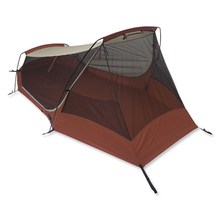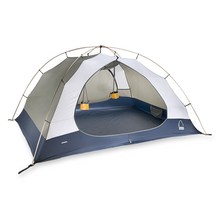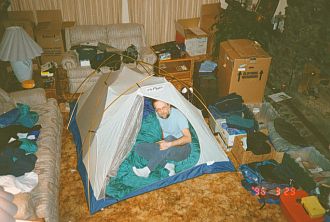Choosing the right TENT for travel.
Most tents - and especially European tents (sorry guys!) - have poor to mediocre ventilation. This is fine when it's cold, you don't want much air flow, you want to keep the heat in.
BUT when it's stinking hot you need all the airflow you can get. And you have to keep the mosquitoes out, so a tarp won't work.
In the 80's I ran a camping and hiking outdoor store, and we sold a lot of tents, both American and European. There was an interesting difference in design philosophy even then, and it seems to still hold. European tents are darker, and are much "tighter" - clearly keeping in the heat and the weather out, especially with low or to-the-ground tent flies. Superb bad-weather tents. The North American tents are more aimed at "fair-weather" camping, and so for us motorcycle travellers get a close look. An interesting side-note - the rain flies are now generally lower down than they used to be, but still not as low on average.
The tent we used in 1987 when we headed off around the world was a North Face dome tent. The top half of the inner tent was unique at the time - it was ALL mosquito netting! In hot weather in Baja it was great, especially with the fly off.

But it did have flaws - it had no vestibule, so dirty boots and riding gear had to come inside with us, and it was heavy and bulky.
A few years later, our next tent was a Sierra Designs Sphinx 3, a big improvement.
Lighter, with a vestibule, and still had plenty of mosquito netting in the top half. I added a removable "tub floor" to the vestibule to keep riding gear from getting wet from the ground, and a good place to put on boots. Still a bit heavy, and the vestibule was very small, and when full of riding gear made getting out of the tent in the night a pain.
Looking for a new tent, I found that there are now a number of great tents to choose from.
My primary criteria for two-up travel (in order):
- excellent ventilation
- 2 vestibules
- 2 doors
- light weight with max floor space
- quick and easy setup
- minimum pegs required
- short poles
- reasonable price
For solo travel of course one door and vestibule is fine - but two would be better!
The more pegs required to set up a tent the more aggravating it is, and the longer it takes. ALL tents need to be pegged in bad conditions, but the fewer needed to set the tent up the better. Tunnel style tents require at least two pegs just to stay up, whereas "free-standing" tents don't, but often require pegs for the fly. I prefer a tent that will set up the inner tent at least without any pegs, and don't mind so much if the fly needs pegging. Most tents will have better ventilation if the fly is pegged and pulled out as far away from the tent as possible anyway.
(All info as of March 2002, updated August 2006, information straight from the websites - I have not tested, nor do I specifically recommend any of these tents.)
From Mountain Equipment Co-op, the premier Canadian outdoor equipment supplier
MEC Netting Wanderer 2 Tent - $199.00 Canadian
Floor area is 3.41 metres square = 36.7 square feet .
Packaged weight is 3.6kg = 7.92lb .
Packed size is 20 x 58 cm = 7.9" x 22.83" .
Canopy can be used without the fly as a bug tent, and there is a footprint available. The poles are all attached together - so you can't lose one!
We just bought one of these, (April 2006) so we'll let you know what we think - in a couple of years! :) Update - tent is excellent, but the footprint is a little small, and only covers one vestibule.
MEC Tarn 3 Tent - $226.00 Canadian
Floor area is 3.45 metres squared = 37.13 square feet.
Packaged weight is 3.44kg = 7.57lb .
Packed size is 20 x 63cm = 7.9" x 24.8" .

MSR Zoid 2, US$219.95 Item 694711 at REI.com
Redesigned - Huge side doors with 4-way, pull-out vestibules provide individual gear storage; configure panels up, down or alternated to vary ventilation.
Average packaged weight 4 lbs. 10 oz. = 2.1kg
Floor dimensions 99 x 57 inches
Peak height 39 inches
Floor area 30 .3 square feet
Vestibule area 11 square feet
Packed size 5 x 16 inches
Pole material Aluminum DAC Featherlite
Number of poles 2
Doors 2


Mountain Hardwear Tri-Light 2 Tent, US$345.00 (no longer available from REI)
Large front vestibule stores gear and UVX windows in rainfly and vestibule provide a skylight effect when the weather is not so good
Average packaged weight 4 lbs. 10 oz. = 2.10kg
Floor dimensions 88 x 54.5 inches
Peak height 35.5 inches
Floor area 28.6 square feet
Vestibule area 10 square feet
Packed size 6 x 18 inches
Pole material Aluminum Easton
Number of poles 3
Doors 1

Sierra Designs Asteroid, US$199.00 (no longer available from REI)
Large Stash Door, surrounded by mesh provides good ventilation; large vestibule with window allows plenty of room to store wet gear outside tent
Average packaged weight 4 lbs. 15 oz. = 2.24kg
Floor dimensions 100 x 82 inches
Peak height 42 inches
Floor area 40 square feet
Vestibule area 10 square feet
Packed size 5 x 20 inches
Pole material Aluminum DAC Featherlite
Number of poles 1
Doors 1

Sierra Designs Antares Tent, US$289.00 Item 667419 at REI.com
Sierra Designs® Antares, a fully featured 3-person freestanding tent, houses everyone and their toys, and comes with an accessory package!
Average packaged weight 8 lbs. 3 oz. = 3.7kg
Floor dimensions 91 x 75 inches
Peak height 45.5 inches
Floor area 49 square feet
Vestibule area 12+12 square feet
Packed size 7 x 24 inches
Pole material Aluminum DAC Featherlite NSL
Number of poles 3
Doors 2

REI Half Dome Plus 2 HC Tent, US$169.00 Item 728308 at REI.com
REI's most popular two-person backpacking tent has been updated-new hub/combi pole design provides greater interior space and easier setup.
Average packaged weight 5 lbs. 11 oz. = 2.6kg
Floor dimensions 90 x 54 inches
Peak height 41 inches
Floor area 34 square feet
Vestibule area 9.4 + 9.4 square feet
Packed size 7 x 23 inches
Pole material Aluminum DAC Featherlite
Number of poles 2
Doors 2

Kelty Riverbend 2 Tent, US$200.00 (No longer available from REI)
Designed with large ceiling and window panels for ventilation, this two-person tent is great for three-season use
Average packaged weight 6 lbs. 5 oz. = 2.87kg
Floor dimensions 89 x 65 inches
Peak height 40 inches
Floor area 34.6 square feet
Vestibule area 8.6 square feet
Packed size 7.5 x 22 inches
Pole material Aluminum DAC Featherlite
Number of poles 2
Doors 1

The North Face Roadrunner 2, US$249.00 (No longer available from REI)
Dual doors allow easy accessibility and venting options, while the double vestibules give lots of room for gear storage
Average packaged weight 6 lbs. 6 oz. = 2.9kg
Sleeping capacity 2
Floor dimensions 91 x 58 inches
Peak height 39 inches
Floor area 35 square feet
Vestibule area 9 + 9 square feet
Packed size 6 x 18 inches
Pole material Aluminum DAC Featherlite
Number of poles 3
Doors 2

The North Face Heron 33, US$349.00 Item 732593 at REI.com
Roomy three-person tent with loads of usable area and spacious vestibules for dirty riding gear, boots and saddlebags.
Average packaged weight 6 lbs. 5 oz. = 2.86kg
Sleeping capacity 3
Floor dimensions 85 x 62 inches
Peak height 41 inches
Floor area 37 square feet
Vestibule area 14 + 14 square feet
Packed size 7 x 22 inches
Pole material Aluminum DAC reverse-combi
Number of poles 3
Doors 2

Tent accessories
For all tents, I always recommend using what's called a "footprint" or ground sheet of lightweight nylon, both as a protector, and to help keep the floor and floor seams dry. It should fit as close to the tent as possible, inside the tent fly protected area. They are available for most good tents, and run US$20-30.
Tent pegs can be aggravating, and I have found that it's worthwhile to carry a selection of pegs. I have finally - after hundreds of pegs - found the perfect peg. For most of the time! My main pegs are made from tent-pole material (Easton Aluminum) and are expensive, but have proven to be worth the money. (US$2.00 from REI, Item 358201), or from MEC 4011-921, CAD$2.00). Very strong, stiff, and at only 15gm, very light, easy to put in most ground by simply stepping on them (they won't bend easily!) and sometimes come with a string to pull them out with. Just add a string if they don't, the hole's already drilled.

I use these for the most important pull-outs, then use lightweight and less bulky aluminum wire pegs for the rest.
I also carry enough snow pegs (US$1.25 from REI.com, Item 358111) to do the main pullouts for very sandy ground. The Easton Aluminum pegs then do the minor pullouts, and the wire pegs are retired)

You should also carry a tent pole repair sleeve in case a pole breaks. Also a package of ripstop nylon tape to patch holes quickly and watertight. A suitable needle and thread should be part of your kit, and a patch of nylon and also no-see-um netting (extra fine mosquito mesh that is used on most good tents).
Inside the tent, a "gearloft" or "attic" is very handy. Watches, glasses, flashlight (torch), toilet paper etc. live there out of the way and easily accessible. It weighs almost nothing, made out of mozzie mesh, and most tents now come with attachment points. Often specific to the tent, though you can adapt many.


Swag pockets are a neat new idea.

Another neat idea is a "wing" tarp.
These are great for sun or rain shelter when cooking or whatever. Small and light.
Moss Heptawing one-person Tarp $150.00 Canadian
Dimensions are approximately 2.9 x 2.9m.
Poles are Easton aluminum, 12.4mm diameter, one 1.47m tall, one 1.12m tall.
Minimum weight (no poles) is 785g, packaged weight is 1.27kg.
Packed size of 10 x 46cm
Moss Vistawing two-person Tarp $210.00 Canadian
Dimensions are approximately 3.7 x 4.6m.
Poles are Easton aluminum, 16mm diameter, 1.82m tall.
Minimum weight (no poles) is 1.93kg, packaged weight is 2.49kg.
Packed size of 13 x 41cm

Tent maintenance
When you first get it, seam seal it immediately, before you use it, and before your sweat and grime prevents the sealer from sticking well, leaving you with having a leaky tent - forever. The seamsealer will stick best on a very clean tent. If it's used, or after years of use you need to redo it, you also need to clean the seams with a special cleaner. Lots of work. Do a good job the first time and it will last a long time. This involves a lot of time (an hour or two!) to do the job right, and the stuff isn't good to breathe, so plan on doing it outside on a nice day.
Set the tent up and smear the seam seal compound on the tent seams. A big thick dribble is not what you want, just a thin coating, no wider than you can, worked well into the threads and seam. Do the floor seams and the fly only.
Some say you don't need to do the fly, but I've watched drips coming through the fly and then through the mosquito netting - onto me! On a conventional tent with nylon roofed inner tent it's less important.
Never put a tent away wet. Great idea, but often can't be helped. So do make sure you air it out as soon as possible, or it will become moldy and mildewed, smell bad, and generally be very unpleasant. Will also damage the waterproofing coating. To remove mildew, use a mix of 1 part common white household vinegar and 5 parts water. Don't soak it for long as it is hard on the tent material. Rinse very well with soap and water, give it a little more scrubbing, and rinse well and set it up to dry.
Never dry a tent in a dryer. The mosquito mesh will melt and shrink. damhik!
To clean it, just use mild soap and a soft brush or sponge, rinse it well and air dry. Large commercial washers are okay too, on gentle cycle.
You can use silicone spray or wax sticks on sticky zipper sliders. Some tents now come with easily field-replaceable sliders. Most can be repaired with a sewing kit and some time. All use "self-healing" nylon-coil zips, which with care can be forced back together if the zip should come apart.
The tent fly IS vulnerable to sun, and will become greatly weakened over a long period. Mountaineers replace the fly regularly, as they have been know to blow apart in a storm after a few years use. Try and camp in shady spots to protect the fly.
Finally, when storing the tent at home, don't leave it squashed into it's stuff sack. Open it out and fold it very loosely, with the fly, into a large bag, preferably cotton so it can breathe. Nylon stuffed away for a long time smells really bad! Always keep the pegs separate in a nylon peg bag to prevent damage.
Member login
Announcements
Thinking about traveling? Not sure about the whole thing? Watch the HU Achievable Dream Video Trailers and then get ALL the information you need to get inspired and learn how to travel anywhere in the world!
Have YOU ever wondered who has ridden around the world? We did too - and now here's the list of Circumnavigators!
Check it out now, and add your information if we didn't find you.
Are you an Overland Adventure Traveller?
Does the smell of spices wafting through the air make you think of Zanzibar, a cacophony of honking horns is Cairo, or a swirl of brilliantly patterned clothing Guatemala? Then this is the site for you!
Hosted by Grant and Susan Johnson, RTW 1987-1998
Next HU Events

Be sure to join us for this huge milestone!
ALL Dates subject to change.
2025 Confirmed Events:
Virginia: April 24-27
Queensland is back! May 2-5
Germany Summer: May 29-June 1
Ecuador June 13-15
Bulgaria Mini: June 27-29
CanWest: July 10-13
Switzerland: Aug 14-17
Romania: Aug 22-24
Austria: Sept. 11-14
California: September 18-21
France: September 19-21
Germany Autumn: Oct 30-Nov 2
Add yourself to the Updates List for each event!
Questions about an event? Ask here
Books

All the best travel books and videos listed and often reviewed on HU's famous Books page. Check it out and get great travel books from all over the world.
NOTE: As an Amazon Affiliate we earn from qualifying purchases - thanks for your help supporting HU when you start from an HU Amazon link!

















